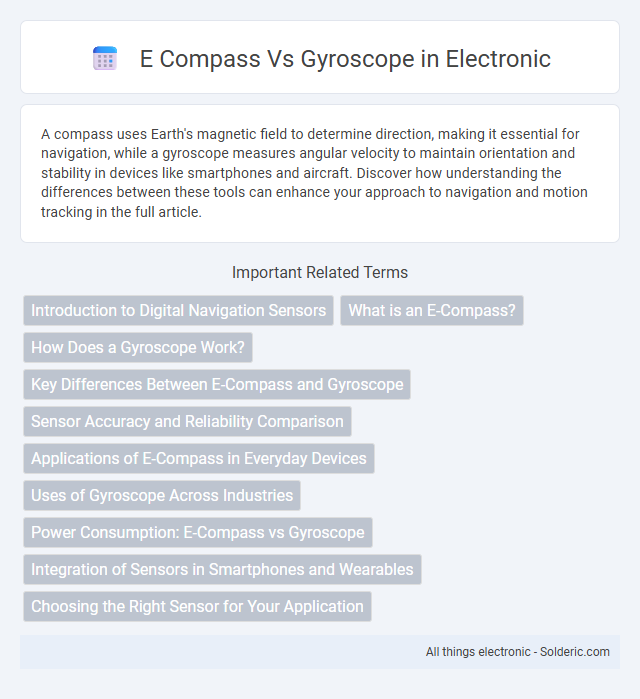A compass uses Earth's magnetic field to determine direction, making it essential for navigation, while a gyroscope measures angular velocity to maintain orientation and stability in devices like smartphones and aircraft. Discover how understanding the differences between these tools can enhance your approach to navigation and motion tracking in the full article.
Comparison Table
| Feature | E Compass | Gyroscope |
|---|---|---|
| Primary Function | Measures Earth's magnetic field for direction | Measures angular velocity and rotation |
| Output | Cardinal direction (north, south, etc.) | Rotation rate in degrees per second |
| Sensor Type | Magnetometer | Micro-Electro-Mechanical System (MEMS) Gyroscope |
| Use Case | Navigation, heading determination | Orientation tracking, motion sensing |
| Accuracy | Affected by magnetic interference | High short-term accuracy, drift over time |
| Power Consumption | Low | Moderate to high |
| Calibration | Requires magnetic calibration | Requires initial calibration; drift correction needed |
| Common Applications | Smartphones, compasses, GPS devices | Gaming controllers, drones, VR devices |
Introduction to Digital Navigation Sensors
Digital navigation sensors like e-compasses and gyroscopes serve distinct but complementary roles in spatial orientation and movement detection. E-compasses utilize Earth's magnetic field to provide absolute directional heading, crucial for compass-based navigation systems in smartphones and wearable devices. Gyroscopes measure angular velocity, enabling precise tracking of rotational movements and enhancing stability in systems such as drones, augmented reality, and vehicle navigation.
What is an E-Compass?
An E-Compass, or electronic compass, uses magnetoresistive sensors to detect the Earth's magnetic field and determine orientation relative to magnetic north. Unlike a gyroscope, which measures angular velocity to track rotation, an E-Compass provides absolute heading information without requiring initialization or external references. Your device's E-Compass is essential for navigation apps and location-based services, offering accurate directional data even when stationary.
How Does a Gyroscope Work?
A gyroscope operates by detecting angular velocity through the conservation of angular momentum in a spinning rotor, allowing it to measure changes in orientation without relying on external references like the Earth's magnetic field. Unlike an e-compass that uses magnetometers to determine heading based on magnetic north, a gyroscope senses rotational movement by maintaining stability in its spinning axis. This capability enables precise navigation and motion sensing in applications such as smartphones, drones, and inertial navigation systems.
Key Differences Between E-Compass and Gyroscope
The key differences between an e-compass and a gyroscope lie in their sensor functions and applications: an e-compass measures the Earth's magnetic field to determine orientation relative to magnetic north, while a gyroscope detects angular velocity and changes in rotational movement. E-compasses are crucial for navigation systems requiring directional heading, whereas gyroscopes provide stability and motion sensing in devices like smartphones, drones, and gaming controllers. Understanding these distinctions can help you select the appropriate sensor for accurate orientation and movement tracking in your technology projects.
Sensor Accuracy and Reliability Comparison
Gyroscopes offer superior accuracy in measuring angular velocity, providing precise orientation data even in dynamic movements, while e-compasses rely on magnetic fields, which can be distorted by nearby metals or electromagnetic interference, reducing their reliability. Gyroscopes maintain consistent performance without magnetic interference, making them more dependable for applications requiring stable and repeatable measurements. You should choose a gyroscope for high-precision orientation tracking and use an e-compass when absolute directional heading relative to the Earth's magnetic field is essential but tolerance for occasional fluctuations exists.
Applications of E-Compass in Everyday Devices
E-Compass sensors are widely integrated into smartphones, tablets, and wearable devices to provide accurate directional orientation for navigation applications. These sensors enhance augmented reality experiences by aligning virtual content with real-world directions and support location-based services such as maps and geo-tagging. Compared to gyroscopes, e-compasses offer low-power consumption and stable heading information, making them ideal for continuous use in everyday consumer electronics.
Uses of Gyroscope Across Industries
Gyroscopes are critical in aerospace for navigation and stability, enabling precise orientation in aircraft and drones. In the automotive industry, they enhance vehicle safety and stability control systems by detecting angular velocity changes. Your smartphone and gaming devices rely on gyroscopes for motion sensing, improving user interaction and augmented reality experiences.
Power Consumption: E-Compass vs Gyroscope
E-compasses typically consume less power compared to gyroscopes because they rely on magnetic field sensors that require minimal energy for continuous operation. Gyroscopes, especially MEMS types, demand higher power due to their need for constant internal mechanical or vibrating motion sensing. Efficient power management in e-compasses makes them ideal for battery-sensitive applications like smartphones and wearable devices.
Integration of Sensors in Smartphones and Wearables
Smartphones and wearables integrate e-compasses and gyroscopes to enhance navigation accuracy by combining magnetic field data with angular velocity measurements. The e-compass provides absolute directional data by detecting Earth's magnetic field, while the gyroscope tracks rotational movements, enabling precise orientation and motion sensing. Your device leverages this sensor fusion to deliver seamless experiences in mapping, augmented reality, and fitness tracking.
Choosing the Right Sensor for Your Application
Choosing the right sensor between an e-compass and a gyroscope depends on the specific requirements of your application, such as orientation accuracy, movement detection, and environmental conditions. E-compasses provide accurate heading information relative to the Earth's magnetic field, making them ideal for navigation and direction-based applications. Gyroscopes excel in measuring angular velocity and detecting rapid changes in orientation, crucial for motion tracking, stabilization, and inertial navigation in dynamic environments.
e compass vs gyroscope Infographic

 solderic.com
solderic.com